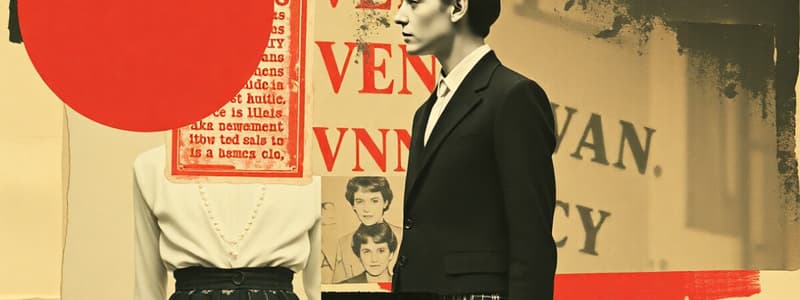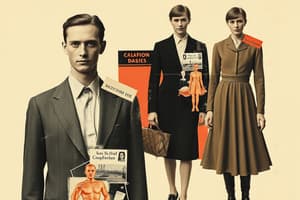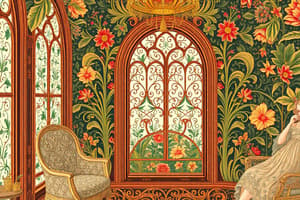Podcast
Questions and Answers
What does a tie generally signify in our culture?
What does a tie generally signify in our culture?
- Elegance
- Sportiness
- Casualness
- Formality (correct)
The meaning of clothing items remains constant across all cultures and social groups.
The meaning of clothing items remains constant across all cultures and social groups.
False (B)
What two levels of meaning are discussed in relation to fashion items?
What two levels of meaning are discussed in relation to fashion items?
Basic level and cultural level
An evening gown signifies __________.
An evening gown signifies __________.
Match the clothing item with its signification:
Match the clothing item with its signification:
Which factor is NOT mentioned as influencing how clothing items are perceived?
Which factor is NOT mentioned as influencing how clothing items are perceived?
Context and combination do not affect the meaning of a pair of jeans.
Context and combination do not affect the meaning of a pair of jeans.
What is the foundation of the semiotic approach in clothing?
What is the foundation of the semiotic approach in clothing?
What do two strips on a Covid test generally indicate?
What do two strips on a Covid test generally indicate?
An exclusive identity conforms to rules and expectations.
An exclusive identity conforms to rules and expectations.
What term is used for someone who does not believe in the existence of a pandemic?
What term is used for someone who does not believe in the existence of a pandemic?
Inclusive identities are the result of an act of opting in, while exclusive identities are the result of an act of opting ___.
Inclusive identities are the result of an act of opting in, while exclusive identities are the result of an act of opting ___.
Match the identity types with their characteristics:
Match the identity types with their characteristics:
Which of the following statements best describes differentiation in identity?
Which of the following statements best describes differentiation in identity?
Modernity has led to exclusive identities being less accepted in cultures.
Modernity has led to exclusive identities being less accepted in cultures.
What is the primary way people differentiate themselves from others?
What is the primary way people differentiate themselves from others?
What is one of the main functions of genre according to Frow?
What is one of the main functions of genre according to Frow?
Genres only restrict how we create meaning, they do not offer any guidance.
Genres only restrict how we create meaning, they do not offer any guidance.
What happens to our expectations if a show labeled as a fantasy does not include any supernatural elements by episode 2?
What happens to our expectations if a show labeled as a fantasy does not include any supernatural elements by episode 2?
Which of the following best describes a cultural narrative?
Which of the following best describes a cultural narrative?
Narratives exist independently of the individual texts in which they manifest.
Narratives exist independently of the individual texts in which they manifest.
Genres can cut across different systems of representation like __________, films, and comics.
Genres can cut across different systems of representation like __________, films, and comics.
Match the following genres with their characteristics:
Match the following genres with their characteristics:
What is a narrative template?
What is a narrative template?
The narrative template 'from rags to riches' emphasizes _____, diligence, and determination.
The narrative template 'from rags to riches' emphasizes _____, diligence, and determination.
Which of the following statements is true about genre?
Which of the following statements is true about genre?
Match the narrative templates with their descriptions:
Match the narrative templates with their descriptions:
Elements such as characters and setting within a genre remain unstable across different media.
Elements such as characters and setting within a genre remain unstable across different media.
How does genre function in relation to systems of representation?
How does genre function in relation to systems of representation?
Which aspect does the 'from rags to riches' narrative typically ignore?
Which aspect does the 'from rags to riches' narrative typically ignore?
Cultural narratives can vary across different cultures and societies.
Cultural narratives can vary across different cultures and societies.
Which gender is typically emphasized in the 'from rags to riches' narrative?
Which gender is typically emphasized in the 'from rags to riches' narrative?
What role does representation play in identity construction?
What role does representation play in identity construction?
Othering is a concept where an identity is constructed by emphasizing similarities with another group.
Othering is a concept where an identity is constructed by emphasizing similarities with another group.
What is the significance of narratives in identity formation?
What is the significance of narratives in identity formation?
The concept of ________ involves the exaggerated or invented differences between two groups.
The concept of ________ involves the exaggerated or invented differences between two groups.
Match the following concepts with their descriptions:
Match the following concepts with their descriptions:
Why might parents be concerned about media consumption by their children?
Why might parents be concerned about media consumption by their children?
Identity markers are fixed and cannot change over time.
Identity markers are fixed and cannot change over time.
How does culture influence identity construction?
How does culture influence identity construction?
What is the primary factor that enables representation to work, according to Hall?
What is the primary factor that enables representation to work, according to Hall?
The color red inherently means 'stop' and green inherently means 'go' in traffic signals.
The color red inherently means 'stop' and green inherently means 'go' in traffic signals.
What does naturalization refer to in the context of cultural processes?
What does naturalization refer to in the context of cultural processes?
According to Hall, the production of meaning through __________ is essential for understanding representation.
According to Hall, the production of meaning through __________ is essential for understanding representation.
Match the color with its traffic light meaning:
Match the color with its traffic light meaning:
What did Hall mean by saying that traffic lights could theoretically use any two distinguishable colors?
What did Hall mean by saying that traffic lights could theoretically use any two distinguishable colors?
The meaning of 'Stop' and 'Go' has been assigned through cultural conventions.
The meaning of 'Stop' and 'Go' has been assigned through cultural conventions.
The meanings assigned to traffic light colors have been __________ over time, making them seem natural.
The meanings assigned to traffic light colors have been __________ over time, making them seem natural.
Flashcards
Representation
Representation
The process by which meaning is created through language and symbols.
Naturalization
Naturalization
The process of making a meaning seem natural and obvious, even though it is a social construct.
Difference
Difference
The idea that meaning is created through the difference between signs.
Combination
Combination
Signup and view all the flashcards
Signification
Signification
Signup and view all the flashcards
Cultural Conventions
Cultural Conventions
Signup and view all the flashcards
Meaning is Fluid
Meaning is Fluid
Signup and view all the flashcards
Interpretation
Interpretation
Signup and view all the flashcards
Meaning of Clothing
Meaning of Clothing
Signup and view all the flashcards
Fashion Interpretation
Fashion Interpretation
Signup and view all the flashcards
Layered Meaning in Fashion
Layered Meaning in Fashion
Signup and view all the flashcards
Cultural Interpretation of Fashion
Cultural Interpretation of Fashion
Signup and view all the flashcards
Group Interpretation of Fashion
Group Interpretation of Fashion
Signup and view all the flashcards
Fashion Item Context
Fashion Item Context
Signup and view all the flashcards
Semiotic Approach in Fashion
Semiotic Approach in Fashion
Signup and view all the flashcards
Agreement and Disagreement in Fashion Meaning
Agreement and Disagreement in Fashion Meaning
Signup and view all the flashcards
Genre: Structure and Guidance
Genre: Structure and Guidance
Signup and view all the flashcards
Genre Expectations
Genre Expectations
Signup and view all the flashcards
Genres Across Media
Genres Across Media
Signup and view all the flashcards
Genre: Restriction and Production
Genre: Restriction and Production
Signup and view all the flashcards
Genre's Level of Operation
Genre's Level of Operation
Signup and view all the flashcards
Genre Example: Term Paper
Genre Example: Term Paper
Signup and view all the flashcards
Genres as Signposts
Genres as Signposts
Signup and view all the flashcards
Genres: Social Constructs
Genres: Social Constructs
Signup and view all the flashcards
Cultural Narratives
Cultural Narratives
Signup and view all the flashcards
Narrative Templates
Narrative Templates
Signup and view all the flashcards
From Rags to Riches
From Rags to Riches
Signup and view all the flashcards
Signification through Difference
Signification through Difference
Signup and view all the flashcards
Identity Construction
Identity Construction
Signup and view all the flashcards
Consumption's Role in Identity
Consumption's Role in Identity
Signup and view all the flashcards
Narratives and Identity
Narratives and Identity
Signup and view all the flashcards
Othering & Identity
Othering & Identity
Signup and view all the flashcards
Identity Markers
Identity Markers
Signup and view all the flashcards
Identity: Contingent and Unfixed
Identity: Contingent and Unfixed
Signup and view all the flashcards
Culture's Influence on Identity
Culture's Influence on Identity
Signup and view all the flashcards
Selection and Combination in Identity
Selection and Combination in Identity
Signup and view all the flashcards
Inclusive Identity
Inclusive Identity
Signup and view all the flashcards
Exclusive Identity
Exclusive Identity
Signup and view all the flashcards
Differentiation
Differentiation
Signup and view all the flashcards
The difference between self and other
The difference between self and other
Signup and view all the flashcards
Model
Model
Signup and view all the flashcards
No Escape from Identity
No Escape from Identity
Signup and view all the flashcards
Identity is not from thin air
Identity is not from thin air
Signup and view all the flashcards
Representations matter
Representations matter
Signup and view all the flashcards
Study Notes
Introduction to Cultural Studies
- Cultural Studies is a field of study that examines the shared meanings of a specific culture or part of that culture
- It is interested in exploring how these meanings are shared and produced
- Everything humans do and produce is considered part of culture.
- Cultural Studies is not a discipline but a field of study that borrows from various disciplines
- Culture is about shared meanings
What is Culture?
- Originally, culture meant cultivation of the earth but now commonly refers to everything that humans create and do
- Culture is everything that is not nature
- A binary opposition exists between nature and culture which suggests different entities
- The concept of culture as a binary opposition is relatively recent
- The narrow definition of culture includes only human products that meet a particular quality standard
- Matthew Arnold defined culture as the best that has been thought and said
What is Cultural Studies?
- Cultural Studies is the study of shared cultural meanings.
- Cultural Studies scholars study texts and images
- Culture and identity are closely connected, so studies can reveal identities.
- Culture studies is not equally concerned with every aspect of culture.
- Cultural Studies is not a formal discipline
- It draws from several disciplines: history, sociology, linguistics etc.
Guiding Questions - Week 2: Representation and Semantics
- Iconic Signs: Signs that resemble their referent (e.g., a picture of a pig)
- Symbolic Signs: Signs with an arbitrary relationship to their referent (e.g., words)
- Indexical Signs: Signs that have a causal relationship to their referent (e.g., smoke as a sign of fire)
- The intentional approach to representation claims that words mean what their authors intend them to mean.
- The reflective approach sees representations as a mirror of reality.
- Cultural Studies aligns with a constructionist view, advocating that words carry meaning by their relation to codes.
Guiding Questions- Week 3: Representation and Semiotics
- Denotation: The simple, basic, common meaning of a sign
- Connotation: Broader themes, meanings, and associations within a culture
- The Circuit of Culture: A model that highlights the complex relationship between cultural phenomena, incorporating production, representation, identity, consumption, and regulation.
- Cultural Studies examines shared meanings in diverse contexts.
The Implications of the Constructionist Approach
- There is no meaning or truth outside of representation and discourse.
- Meaning is constructed in representation.
Guiding Questions - Week 3: Medium and Discourse
- Medium: A particular system of communicating ideas, characterized by specific material and technological conditions
- Discourse: A group of statements constructed about a topic that determines what can be said about it
- Discourse operates on a cultural level
- Discourse is concerned with how ideas are communicated across multiple forms of media— not only texts, but also images, practices, and so on.
Guiding Questions - Week 4: Genre and Narrative
- Genres: Categories of artistic, musical, or literary works based on style, form, or content. Shared characteristics help structure interpretations.
- Narrative: A representation of a sequence of causally connected events.
- Genres are culturally constructed and fluid.
- Narrative is used in many cultures as a method to explain and make sense of situations.
Guiding Questions - Week 5: Individual and Collective Identity
- Identities are produced internally and externally: Identity is constructed
- Structural racism: Is when racism is inscribed in institutions, laws, and policies.
- Class: A concept connected with power and economic status, both individually and collectively, in class distinctions.
Guiding Questions - Week 8: Queerness and Intersectionality
- Queerness challenges binarism. It is not limited to sexuality.
- Intersectionality: Identities intersect, creating specific sets of privilege/oppression.
Studying That Suits You
Use AI to generate personalized quizzes and flashcards to suit your learning preferences.




